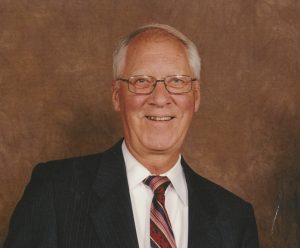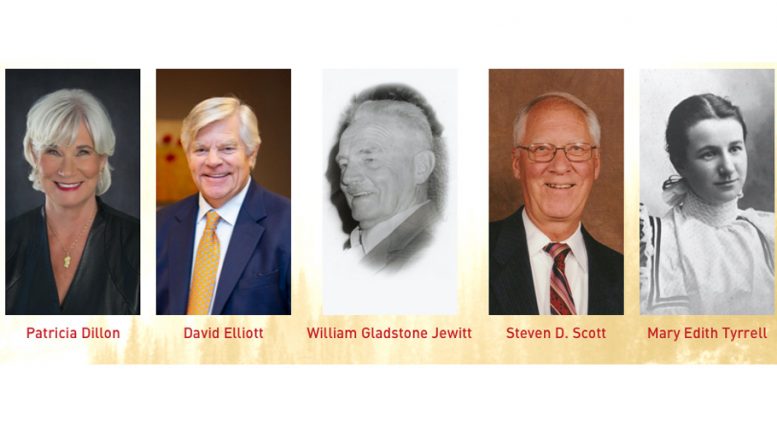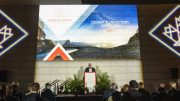The Canadian Mining Hall of Fame will welcome five new members at its July 2021 gala dinner and induction ceremony, An Evening Under the Stars, to be held at the prestigious Aga Khan Museum in Toronto.
Due to the Covid-19 pandemic and the restrictions around gatherings, the gala dinner and induction ceremony will be organized in compliance with Ontario’s Phase 3 guidelines where 100 people are permitted to meet outdoors in a business venue, with health protocols monitored and safe distancing implemented. This event is by invitation only with no public sale of tickets.
The Northern Miner is a cofounding member organization of the Hall of Fame, along with the Canadian Institute of Mining, Metallurgy and Petroleum, The Mining Association of Canada and The Prospectors and Developers Association of Canada. More details about the event can be found at www.mininghalloffame.ca
Patricia Dillon (b. 1952)

Patricia Dillon
The career achievements of Patricia (“Pat”) Dillon are unique in Canadian mining history as they encompassed leadership roles in industry associations and outreach initiatives to help the sector navigate social change and chart a more sustainable future. She joined Teck Resources as a geologist in 1979, and advanced to more senior roles as her organizational and communication skills came to the fore. This experience was a springboard for volunteer positions with the Prospectors and Developers Association of Canada (PDAC) and Canadian Institute of Mining and Metallurgy and Petroleum (CIM). She served as committee chair, board member, and president of both organizations, and was an early advocate of Corporate Social Responsibility (CSR). Dillon also contributed to the CSR initiatives of the Mining Association of Canada (MAC), notably “Towards Sustainable Mining” and “Mining Works for Canada”. Her greatest contribution is as a founder and driving force of Mining Matters, a charitable organization focused on educating young people about Earth sciences, the minerals industry, and their roles in society.
Dillon was born in Toronto and attended the University of Toronto, where she earned a BSc in geology in 1974, and a Bachelor of Education in 1976. Geology was not a common career choice for women at the time, but her entry position with Teck evolved into a 32-year career and ultimately made her one of the best-known industry leaders of the 1990s and early 2000s. The industry faced many challenges at the time, and its associations recognized that something had to be done to improve performance and increase knowledge of the mining industry with governments, educators and the general public. Dillon played a leadership role in MAC’s innovative “Towards Sustainable Mining” initiative, which led to improved relations between the Mining Industry and Indigenous Communities, in particular.
Dillon has contributed greatly to the success of PDAC in various capacities since 1993, including as president from 2006 to 2008. She was the chair of Mining Millennium 2000, a conference held jointly by PDAC and CIM that included forums on CSR and the future role of mining in society and was a member of the PDAC committee that developed the original E3 initiative. As well, she was chair of the Ontario Mining Association’s “Mining New Opportunities” video project for Ontario First Nations. Dillon is the past chair of the Mining Industry Human Resources Sector Council and co-chaired its National Steering Committee, which produced the “Prospecting the Future Report” in 2005. She also served as chair of the Communications Task Force of the International Council of Mining and Metals.
Dillon’s most enduring legacy is considered to be PDAC Mining Matters, a charitable organization that celebrated its 25th anniversary in 2019. She serves as president and CEO of the organization, which has provided educational resources promoting mineral literacy to more than 800,000 students and teachers in Canada, in English, French and several Indigenous languages.
Patricia Dillon has received the CIM’s Past Presidents’ Memorial Medal, Distinguished Service Award, and Fellowship Award, and PDAC’s Distinguished Service Award, in recognition of her achievements. She is also the recipient of the Queen Elizabeth II Jubilee medal, was named a “Superhero of Industry” by the Canadian Science and Technology Museum and recognized as one of the 100 Global Inspirational Women in Mining in 2014 by Women in Mining (UK).
David Elliott (b. 1948)

David Elliott
David Elliott earned his reputation as one of Canada’s preeminent resource financiers by funding more than 400 exploration and development companies and supporting and mentoring a generation of mining geoscientists. As a founding partner of Haywood Securities, he demonstrated a rare ability to combine industry talent with quality projects and investment capital. Haywood grew from a small Vancouver firm with 15 employees in 1986, into one of Canada’s premier mining merchant banks with 300 employees and $10 billion of assets under management. Elliott was a stalwart champion of junior mining, even in tough times, and an early supporter of many of its greatest successes, notably diamond discoveries in Canada and the Pierina gold mine in Peru. He is known and respected for his acumen, integrity, and core principle of investing in people over transactions. He is also a generous supporter of worthy social and environmental causes.
Elliott was born in Kingston, Ontario, and began his career as a junior programmer at the Montreal Exchange in 1968. A year later he became a securities trader at the Montreal brokerage firm of Dougherty Roadhouse MacQuaid and was transferred to Vancouver. He spent several summers prospecting in the Yukon where he worked in mining finance and trading at several brokerage firms. In 1986, he seized the opportunity to purchase Haywood with partners David Shepherd, John Tognetti, Rob Blanchard and George Bealy. It was then a small shop, but the partners saw potential for growth. They bought a seat on the Toronto Stock Exchange and launched an ambitious plan to build a strong base of retail sales personnel and clients, and raise capital for junior mining companies.
As a partner and director, Elliott helped strengthen Haywood’s research, corporate finance and compliance departments during the 1990s. An institutional desk was added in 1998. During this period, he focused on building relationships with companies led by strong technical teams. He had previously supported the first heap-leach gold mines in the United States, and later became involved in a predecessor of Glamis Gold, which was acquired by Goldcorp for US$8.6 billion in 2006. He partnered with Stewart Blusson on the formation of Pioneer Metals and supported Blusson’s early exploration efforts for diamonds in the Canadian Shield. He also participated in an initial $5-million financing for Arequipa Resources, which discovered the 10-million-ounce Pierina gold deposit in Peru. Barrick Gold ultimately acquired Arequipa for $1.1 billion in 1996.
The list of companies and people that Elliott supported over four decades is long, but includes the Bema Group, Alamos Gold, CGA Mining, Globetrotter Resources, Midas Gold, Ventana Gold, Reservoir Minerals, Fiore Gold, EMX Royalties, and Transition Metals, among others. The impact on the Canadian mining industry is similarly vast, and hugely beneficial in preserving the junior mining sector and establishing Canada as a global financial hub for resource investment.
In 2014, Elliott was presented AME BC’s Murray Pezim Award for “perseverance and success in financing mineral exploration.” His philanthropic efforts, often anonymous, are diverse and include the Pacific Salmon Foundation, Fraser River Sturgeon Conservation Society, Alzheimer’s Society of BC, Covenant House, BC Children’s Hospital, Vancouver Hospital Cancer Foundation and Prostate Cancer, Make-A-Wish Foundation and Women in Mining.
William Gladstone Jewitt (1897-1978)

William Gladstone Jewitt
William (“Bill”) Jewitt has the rare distinction of being an inductee into the Canadian Mining Hall of Fame (2021) and the Canadian Aviation Hall of Fame (1978). He was a pilot and flight instructor during the First World War, a mining engineer by profession, and a senior executive of Cominco, which continues as Teck Resources Limited. He joined Cominco in 1927, and contributed to the discovery and development of many of its mines by combining “eyes in the skies” aerial prospecting with “boots on the ground” engineering expertise. The list includes famous mines such as Echo Bay, Con, Thompson Lundmark, Ptarmigan and Pine Point.
Bill Jewitt was a teenager when his family emigrated from England to Canada in 1910. They settled in Calgary, where his father worked as a school teacher and principal. He became the first King Scout in Alberta, which foreshadowed a remarkable career. As war broke out in Europe, Jewitt enlisted with the Princess Patricia’s Canadian Light Infantry and saw action as a machine gunner in the trenches of France. He transferred to the Royal Flying Corps and became an instructor and test pilot for the Royal Air Force in Europe. Jewitt continued to fly after the war and survived a spectacular collision with another aircraft, returning to Canada after overcoming his injuries.
Jewitt graduated with honours from the University of Alberta in 1923, with a BSc in mining engineering. He joined Cominco as an assayer at its Trail smelter in B.C., and transferred to the mining group as an exploration engineer and pilot in 1929. The company then had 12 planes in service exploring unmapped territory in Canada’s North. Jewitt trained company engineers and geologists to fly as part of their exploration responsibilities and also made lasting contributions to mapping and mineral exploration in Canada’s North, notably in the Northwest Territories (NWT). His own exploration efforts led to the opening of the Box gold mine in northern Saskatchewan, and the Con gold and Echo Bay silver mines in the NWT. He negotiated an agreement leading to discovery of the Magmont Mine in Missouri.
When Jewitt’s aviation career ended in 1954, he had personally flown the farthest-ranging and most difficult flights, some into the Arctic islands where no aircraft had ventured. He pioneered new methods of aerial prospecting and carried out emergency flights under difficult conditions.
In 1948, Jewitt was appointed manager of mines, and became vice-president of mines in 1952. Under his direction, Cominco modernized the Sullivan mine, then the world’s largest lead-zinc-silver mine, and developed the Bluebell, HB, Tulsequah Chief, and Coast Copper base metal mines, and Pinchi Lake mercury mine in B.C.; the Wedge copper mine in New Brunswick, and the Nong Bhai mine in Thailand.
He retired from Cominco in 1962, but continued as president of Pine Point Mines and Coast Copper Mines. He later served as president of Western Mines until 1977, and contributed to the success of its Myra Falls copper-lead-zinc mine on Vancouver Island.
In 1956, Jewitt received an Honorary Doctorate degree from the University of Alberta for his contributions to mining and exploration in Northern Canada. In 1978, he received the Order of Polaris from the Yukon government in recognition of “an outstanding role as a pioneering aviator in the Canadian North,” and “for courage in navigating the uncharted wilderness.”
Steven D. Scott (1941-2019)

Steven Scott
The oceans of the world and volcanogenic massive sulphide (VMS) deposits were sources of inspiration for Steven Scott, one of Canada’s most prolific and influential geoscientists of recent times. His legacy of scientific research is second to none, and complemented by a stellar 40-year career at the University of Toronto. Scott joined U of T in 1969, and was then its youngest professor. A landmark achievement of his early career in research, as an experimental geochemist, was development of the “sphalerite geobarometer,” a tool for estimating temperature and pressure of formation or metamorphism of ore deposits to help predict the mineral content of VMS deposits. In the late 1970s, he turned his attention to “black smokers” and the genesis of seafloor massive sulphides, and ultimately became a world-famous marine scientist. He was the first to recognize that seafloor deposits could be an economic resource and worked with several mining companies to pursue this goal. He participated in 31 oceanographic expeditions, published hundreds of peer-reviewed scientific papers, and educated students from around the world—since labelled the “Scott Diaspora.”
Born in Fort Frances, Ontario, Scott attended the University of Western Ontario, and earned his BSc and MSc degrees in geology in 1963 and 1964, respectively, followed by a PhD from the Pennsylvania State University in 1968. At U of T, his seminal research on ancient VMS deposits included comparative studies of the 13-million-year-old Japanese Kuroko-type VMS deposits with 2,700-million-year-old Canadian massive sulphides. His research helped guide exploration efforts for high-value VMS deposits in Canada and abroad. This fount of knowledge also aided Scott’s research efforts during the third phase of his career as a marine geoscientist.
The 1978 discovery of “black smokers” on ocean ridges generated excitement among geologists. In 1982, Scott went on his first expedition, diving in the submersible ALVIN to Guaymas Basin, Gulf of California. He was the first geologist and first Canadian to witness the formation of metal sulphide deposits by hot spring activity on the modern seafloor. This was followed by a surface and diving cruise to Axial Seamount, Juan de Fuca Ridge, in 1983, and more than 25 other expeditions in oceans of the world. Based on the principle that “the present is the key to the past” Scott and his research teams compared the active live deposition sites they found on the sea floor to ancient VMS deposits on land. He saw potential for ocean deposits to become an economic source of base and precious metals, and guided Nautilus Minerals for this purpose. During this period, he co-discovered the Solwara 1 copper-gold deposit offshore of Papua New Guinea. While not yet developed, this deposit demonstrated the potential of marine resources.
Scott published 187 peer-reviewed journal articles and conference proceedings during his career and also was a popular lecturer. He guided dozens of students through their MSc and PhD theses, including some who became experts in seafloor research. He received dozens of national and international honours over the years, notably the Society of Economic Geologists’ Penrose Medal in 2016, and the Geological Survey of Canada’s Duncan R. Derry Award in 1997.
Mary Edith Tyrrell (1870-1945)

Edith Tyrrell
Career options for women were limited in the 1890s when Edith Tyrrell was introduced into Canada’s fledgling mining industry as the young wife of Joseph Burr Tyrrell. He was a renowned explorer and map-maker with the Geological Survey of Canada (GSC) when they met, and often away on long expeditions. By the time they married in 1894, Edith Tyrrell had studied geology and experienced the separations endured by many mining families. In Toronto during the First World War, she recognized the need for the wives of mining men to support each other. In 1921, she and 19 like-minded wives launched the Women’s Association of the Mining Industry of Canada (WAMIC). Since then WAMIC members have overseen the distribution of more than $1.8 million in charitable donations and support for students and educational institutions. It is fitting that a century later Edith Tyrrell be inducted into the Canadian Mining Hall of Fame, joining her husband who was inducted in 1997 for his career accomplishments.
Mary Edith Carey was born in Saint John, New Brunswick, and nicknamed “Dollie” as she weighed only three pounds at birth. She was not strong enough to attend school, but spent considerable time in the family library as her father, a Baptist minister, believed in the higher education of women. After 17 years in Saint John, the family moved to England, where Edith attended high school. Six years later they moved to Ontario, where Reverend Carey was appointed to the First Baptist Church of Ottawa. It was there that Edith met her future husband, who a few years earlier had discovered dinosaur bones and coal deposits in Alberta.
The Tyrrells raised three children and travelled extensively during their marriage, including to the Yukon during the Klondike gold rush. In 1905, they moved to Toronto, where he could further his business as a mining geology consultant. She witnessed mining history by his side as major discoveries were made in northern Ontario and across Canada. During the war years she joined the Women’s Auxiliary of the American Institute of Mining and Metallurgical Engineers and saw the need for a similar group in Canada. In March 1921, she gathered together a group of other mining wives to launch WAMIC. Its objectives remain to promote friendship among mining women, render service to the mining industry, and contribute to the well-being of the community.
Mrs. Tyrrell served as WAMIC’s president for its first three years. Members supported worthy causes that mirrored the times; war veterans in the 1920s, schools and disaster relief in the 1930s, and the war effort in the 1940s. Over the past century WAMIC has donated more than $300,000 to various charities, awarded more than $300,000 in scholarships and bursaries, and overseen the distribution of $616,000 to deserving students from the Sophia Wood bequest. Another $600,000 was distributed to several universities and the KEGS Foundation as the WAMIC Foundation wound down in 2010. WAMIC has supported countless students over time, including women and minorities, and helped the mining industry in its transition from a fraternity into an inclusive community.




Bill Jewitt – a splendid choice. He was Chairman of Western Mines when I joined as President at the end of 1974. A man of imagination, integrity and courage. Would that we had leaders of his calibre today.
Thank You Hugh Snyder! Our family was blest by Bill Jewitt, my father & mentor.